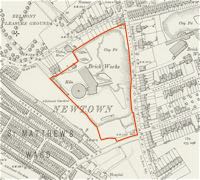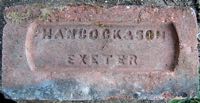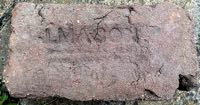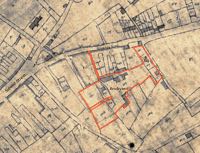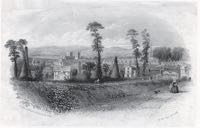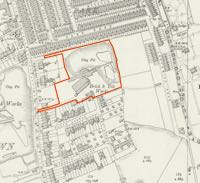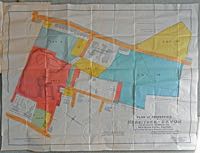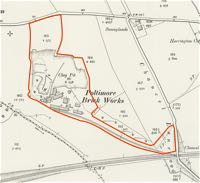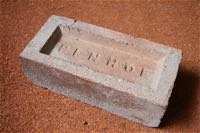
Exeter's Brickworks
Latest update 17th September 2018
Return to Industrial Exeter
There is evidence of brick and tile making in Exeter since Roman times, and the recent archaeological excavations at Princesshay have uncovered a Roman site, close to the city wall, that was used for tile making. The quarrying of clay moved away from the city centre in medieval times towards the area around Newtown and further out to the east of the city in Polsloe and Pinhoe.
During the nineteenth-century, brick works could be found even in the smallest town, so long as there was suitable clay. Kingsteignton, Ottery St Mary, Morchard Road near Crediton, Rockbeare and Exmouth all had their own brickworks.
The Corporation Brick Works, Clifton Hill
Clay for bricks has been quarried from Polsloe Ridge for hundreds of years, and the quarry was known, in 1674, as Round Pitts. In fact, the growth of St Sidwells was partly due to the employment available in the brick fields during the 16th and 17th century. Exeter's Custom House was built in 1680, the oldest surviving brick structure in the city, giving evidence of the fledgling brick industry in the city.
Corporation of the Poor
By the 19th-century there were at least six brickworks in the city, one of which was run by the Corporation of the Poor. The Workhouse Works, was supplied with workers from the Workhouse. It was situated on the Clifton Hill Sports Centre site, with the quarry stretching from the dry ski slope under Polsloe Road to the rockery of Belmont Park. It was first mentioned in April 1825 as the City Brickfield behind the Workhouse, when a tender was put out for Newcastle or Sunderland coal to be supplied to the works.
Robert Harvey, mason and bricklayer of Waterbeer Street, erected a cone for firing the bricks in December 1834 on the brick field. At its base, it was 59 ft in diameter and 7ft 6ins at the top. A 100 ft and 6 inches high, it used 220,000 bricks, which along with the mortar, weighed 825 tons. The project was commissioned by the Corporation of the Poor and took Harvey eight weeks to complete. Maps from the 19th century show the cone clearly, behind what is now the Clifton Hill Sports Centre.
By January 1839, the Corporation was concerned about the debts run up by the brickworks, but they continued to run the works, only for their concerns about bad debts owed to the works to re-emerge in 1850. John Curry the foreman resigned in 1848 and the Brickfield Committee resolved to find a replacement who would be provided with a house and coal. The Brickfield Committee was dissolved in 1850 and their duties taken over by the Committee of Nine. The Brickfield incurred a loss of £418 in the year up to April 1851. In 1855 a meeting again discussed finances and it was noted that in the previous year the brick field had lost £116, with wages running at £461, while in 1853 it had made £411.
Death of a 12 year old
It was a dangerous and dirty working at the brick field, as demonstrated in August 1849 when 12 year old John Jordan was killed. He was said to have interfered with a gear while the machine for grinding clay was working, jamming his hand between some boarding and the machine. He had a finger amputated at the site, and the trauma was such, that he later died in hospital.
An advert in 1853 by Mr Mason's Brickmaker at the brick field indicates they could supply bricks from the 25 April under his supervision. James Mason would run the works until January 1859, when he resigned just before the works went into private ownership. In June 1853, the Corporation of the Poor decided to purchase a Clayton's brick-making machine, which could produce 7,000 to 10,000 bricks per day. Formerly, the lack of skilled moulders often meant that the workhouse workers who serviced the skilled men were left idle.
In 1855 a case by the Corporation of the Poor, against Joseph Sylvester who had become destitute, indicates the wages of the brick field workers. He refused to work in the brick field for 6d a day and requested he work breaking stones for 1s per day. He claimed he could not keep his family on the pay from the brick field. He was sentenced to a week's imprisonment with hard labour for refusing to work.
In 1856 it was obvious that the responsibilty for running the brick field by the Corporation of the Poor was near the end, when the Chaplain of the Workhouse thought that its abolition would be of benefit to the morals of the inmates. In the same year the Commission had a lengthy discussion about closing the brick field. Some objected to children under 15 working there, and it was considered to be "a school of vice and immorality". It had lost money in the previous three years, which was put down to mismanagement. Thomas Latimer contended that "He had always entertained the opinion that a public body ought not to engage in an enterprize such as a brick field, and compete against the upright and striving tradesmen".
The end came in March 1860 when the Commission advertised the "Brick and Tile Yard Known as the City Brickfield" for let. The established business included a dwelling house, yards, sheds, lofts, kiln, office and clay mill, as well as "one of the richest Beds of Clay in the Country".
Hancock and Sons
Between 1860 and 1939, the works were owned by J Hancock and Son, brick makers. John Hancock was born in Taunton where he started working at a brick and tile works for 6d a day. He found his way to Exeter and in 1860 he purchased the Workhouse brickworks from the Council. He lived at 18 Clifton Hill.
Hancock started to improve the works and there was a reduction in the price of bricks in 1871, partly due to increased competition; the works offered bricks at 25s per thousand, with an extra discount for cash. In April 1872 Engineers were engaged to blow up a large chimney in the brick field, but locals were concerned that the demolition may damage their property. They attacked and assaulted the Engineers, preventing the destruction.
The Exeter Improvement Commission considered the case of Hancock erecting a second cone on the site which was close to some existing houses. They decided that if a nuisance, Mr Hancock should be held responsible.
Hancock's supplied bricks to the City Council in July 1876 when they made a payment of £24. The works was advertising all sizes of drainpipe throughout 1881, which were needed for the building of the many terraces that were appearing in Exeter. They also supplied the brick for a new church at Yeoford in 1891.
Fatal accident
In July 1889 there was an accident at the works when Mr Henry Giles, 58 who was employed as a clay-digger, was killed. A load of clay fell on the worker from a height of about 35ft, covering him up to the waist with clay, and knocking him against a trolley; his workmates extricated him from the clay and he was rushed by cab to the hospital where he died; a rib had penetrated his lung, and he had suffered intestinal injuries. Giles had worked for Hancock's for 10 years, and it was their first fatality for 32 years.
John Hancock died in 1906 leaving a fortune of £160,000. The brickworks continued under his name until the outbreak of the Second World War. When Exeter was rebuilding, after the blitz, material from the bombed and demolished buildings, and the spoil from digging new sewers, was dumped in the clay pit to level it. This was one of several places in Exeter that was filled with spoil, including the low land between Barnfield and Magdalen Road above Bull Meadow, which would take the new road between the Paris Street roundabout and Magdalen Road.
Once the pit was levelled, much of the area was given over to allotments before it was converted into a sports field for the Clifton Hill Sports Centre. Now the pit is a golf driving range with an artificial ski-slope at one end.
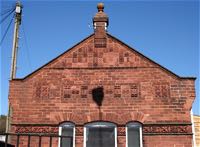
The only surviving building from the works, has elaborate, decorative brickwork to show the quality of the product.

The traction engine of J Hancock & Son was built in 1912 and named 'City of Exeter'. It has been restored and renamed 'Dalesman'. Photo by David Collidge of the site, Steam Scene.
Other brickworks
Blackboy Road
Mr Thomas W Horrell was a member, for several years, of the Commission of Improvement. Upon the death of his father, in 1839, who had been a builder, he decided to close the business and become an architect and surveyor. He kept his already established brick works, that was situated between Blackboy Road and Clifton Place. The works had two entrances; the first from Blackboy Road and the second, from Grosvenor Place. This would place the brick works between Grosvenor Place and Silver Lane.
Mr Horrell put up the works for sale in 1842 "well supplied with clay... carried on upwards of forty years... enclosed Kiln and Cone, extensive and convenient Tile Sheds, Hot Air Room and Tile Mills, Hack grounds, Stabling and Gig House." It couldn't have sold because in 1848, the works was up for sale again as a brick works or as valuable building land. There are no other references to the yard after this date, although in December 1849 there is a notice of the death of "Thomas Wills Horrell, late of this city", at Port Phillip.
Sampson's Brick Yard - Polsloe Park
Mr John Sampson ran the brickworks off Polsloe Road, next to Park Avenue for many years in the second half of the nineteenth-century. He was born at South Tawton and lived at Floriston Villas, Polsloe Road in 1881 when he was listed as employing 20 men and boys. In 1897 he was listed as 'John Sampson, brick & tile manufacturer, proprietor of patent vans for removing furniture, agent for London cement, glazed pipes & the Dorset Lime Co. Polsloe road.' Mr Sampson placed several adverts for items and property for sale, with the address 'Brickworks'. In 1894 he advertised for a vertical, 12 horse power engine, but it is not clear if it was for his brickworks.
Sampson moved to a house on the corner of Polsloe Road and Sampson’s Lane, next to his brick works, named Melrose, a substantial property described as ’a 14 room villa residence’. He became a wealthy businessman, off the back of his brick making.
John Sampson died in 1910 and a sale was held of his brick yard and land by Herbert A Fulford at the Half Moon Hotel on the 22 September 1910. The first lot comprised of the goodwill plus the brick yard with a large number of outhouses including cement store, wheelwright’s shed, blacksmith’s shed, gas engine house, machine house, coach houses, cart sheds, stabling etc, along with buildings, cottages and five acres of land. Other lots consisted of thirteen acres of land for building, a 14-bedroom villa named 'Melrose' and three dwelling houses named Polsloe Villas. He also owned other property in Heavitree, Wonford, Fore Street and St Thomas. There are no other records of the existence of the brick yard after the sale. Sampsons Lane is named after his brickworks. The land is now the playing fields of Ladysmith School.
Source: Newspapers, sale documents and with thanks to Dick Passmore for additional research.
Heavitree
There was also a brickworks in Heavitree which was referred to regarding a cholera hospital placed there in 1870. Mr Pengelly the owner, advertised in 1874 as the Heavitree Brick and Tile Yard, with "hard brick, ash burnt at 25s per thousand". In March 1875 this advert appeared: "Freehold Messuage, Brick Kiln, Stables, Brickfields and Premises, comprising about 3a 0r 25p of land at Heavitree aforesaid, and now in the occupation of Mr Pengelly."
Rougemont Works
Another brickworks was situated in the Polsloe Priory Estate, next to the Exmouth Railway line, on Monks Road. Named the Rougemont Brickworks, it was opened as the Exeter Brick and Tile Company in 1898/9. In the 1930s easier road transport meant that bricks could be brought in from further afield, and a period of consolidation and closures of brick works in the south-west saw the Rougemont works become part of the Western Counties Brick Co.
The works had a Hoffman continuous kiln and four cone type kilns on site, capable of producing 100,000 bricks a week. By the 1970's the Western Counties Brick Co. became Westbrick, and the Rougemont works continued manufacturing bricks and tiles using the Hoffman continuous kiln along with a modern tunnel kiln. The deposits of clay were worked out, so clay was brought in from the Pinhoe works, also part of Westbrick, but for the size of the market, there was overcapacity at the works. By the 1980's the site became a depot for Westbrick who were taken over by Ibstock, a Leicestershire based company. As late 2000, the works were still open, and Charlie Dimmock, the TV gardener took a delivery of bricks and pavers for a TV project in Torrington. The site has been land filled and levelled and redeveloped as the housing of Cloister Road and Greyfriars Road.
Poltimore Brick Works
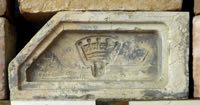 The
sixth brickworks was situated out at Pinhoe, on what
is
now the trading estate. Known as The Poltimore Patent Brick & Tile Works, with J. & W.J. Saunders, as proprietors, from about 1893 to 1923. The photo (Courtesy of Martyn Fretwell), left, shows a specialist brick made when the brickworks was run by Saunders. The works were the last to be active in Exeter and finally
closed in 2008.
The
sixth brickworks was situated out at Pinhoe, on what
is
now the trading estate. Known as The Poltimore Patent Brick & Tile Works, with J. & W.J. Saunders, as proprietors, from about 1893 to 1923. The photo (Courtesy of Martyn Fretwell), left, shows a specialist brick made when the brickworks was run by Saunders. The works were the last to be active in Exeter and finally
closed in 2008.
Source: Various sources including contemporary maps, Victorian Exeter by Robert Newton, the Flying Post and
│ Top of Page │
